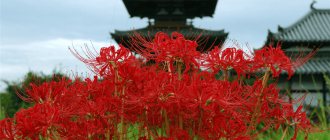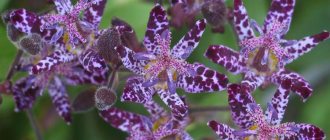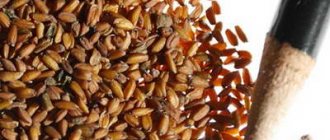Erantis is still a rare plant in our gardens. A novice florist may be put off by the intricate and little-known name, but I dare to assure you that it is not complicated in agricultural technology. And it will more than repay you for your worries with bright, soul-pleasing sunny blooms! Erantis is also called “spring flower”. It has single, open yellow flowers. He won my heart with the fact that these tender, red heads appear straight from under the snow! The spectacle is mesmerizing and pleasing.
Erantis, or Springflower (Eranthis) is a genus of perennial plants of the Buttercup family (Ranunculaceae).
Wintering Eranthis, or winter (Eranthis hyemalis). © beranekp
2. Vesennik - planting and care
Spring grass can be planted in open ground as seeds. and grown nodules. Adult plants are planted during the dormant period, when the above-ground part dies off, usually in the fall.
Before planting, if necessary, spring spring tubers are placed in a cool place with air humidity of about 60 - 70 percent. Before storing, put the tubers in small containers and add drops of wet sand. After storage, before planting, the nodules that have lost moisture should be soaked in warm water for 6 - 8 hours.
↑ Up,
Since spring flowers can spread in the garden on their own with the help of seeds, it should be planted in fenced areas where this primrose will not interfere with other plantings.
The plant develops well both in well-lit areas and in partial shade. The types of spring flowers that tolerate partial shade best are Erantis stellata and Siberian.
Taking care of a flower does not require much effort or time - just water it if the soil becomes too dry, loosen and weed the area where the primroses sit.
↑ Up,
The plants also do not need a large amount of nutrition, but once a year, in the spring months, you can fertilize them directly in the snow by scattering granules of flower fertilizers.
Every 5 - 5 years the flower is replanted and divided as described below.
This species winters well in the middle zone and does not need additional shelter.
↑ Up,
Erantis care
And in the third year, in the spring, our Erantis blooms. And then it will be easier. Vesennik reproduces well by self-sowing. But he cannot be called an aggressor or invader. He loves light, loose, slightly alkaline soil. It does not tolerate stagnant water at all. It tolerates shading and can be used to decorate the trunks of fruit trees. This coexistence is convenient because after the foliage dies, and this happens in June, the soil must be kept clean. I mulch the tree trunk circles and don’t plant anything else in this place, I just water it and occasionally feed it. This also benefits fruit trees.
The spring tree must be replanted after five years.
The main thing is not to be lazy and do everything in due time! It is important to approach gardening with love and patience.
3. Reproduction of spring flowers
There are 2 possible ways to propagate a flower - by dividing adult plants or sowing seeds.
↑ Up,
3.1.Growing from seeds
Spring grass is propagated by seeds that have previously undergone stratification in a cool place with a temperature of -4 to 4° C for 6 to 8 weeks. It is interesting that only species-specific bushes can be propagated by seeds; this cannot be done with varietal plants - even in the case of cross-pollination, they do not form seeds. For stratification, planting material is mixed with a small amount of wet river sand, perlite or moistened vermiculite and placed in a plastic bag.
To propagate plants, you can use your own collected seeds. The collection of planting material is carried out after full ripening - in the summer, choosing a fine - warm and clear day - for this procedure. You can plant the seeds in open ground immediately after collection - at the end of summer or autumn, in which case they will undergo stratification naturally, or postpone this procedure until spring.
↑ Up,
Sow the seeds in furrows (about 2 cm deep), in an area with good lighting or in the lacy shade of trees and shrubs. You should not plant spring flowers in flooded lowlands - water accumulating at their bottom in the spring months forms a crust of ice through which the flower cannot break through. If the soil on the site has an acidic pH, it should be adjusted towards neutral or (better) slightly alkaline. To do this, crushed chalk, lime and dolomite flour are mixed into the soil.
At home, keep the crops cool - at a temperature of about 10 ° C, under a plastic cap or glass to maintain uniform humidity. Plants obtained from seeds sown in spring will bloom early next summer, while those planted in autumn will bloom only in the third year - in winter or spring. Perlite or sand is added to the planting soil to improve drainage.
↑ Up,
If you follow the rules of agricultural technology, germination takes 2 - 4 weeks.
In the first year, only cotyledons can be seen, and only for a short period of time - about a month. At this time, all the energy of the plants goes to the formation of the root system and the first leaves simply die off. Under the ground, such plants will become the owners of small nodules - their size is often no larger than the head of a pin.
The first true leaf blade is formed in plants of the second year of life - such specimens can already be transplanted to a permanent place. Since spring flowers look good in fairly dense plantings, when planting, the distance between plants is maintained at about 6 - 8 cm.
↑ Up,
3.2.Transplanting and dividing adult plants
Since over time the bushes form underground daughter nodules, the plants become crowded - a deficiency of nutrients and moisture occurs. To ensure that this condition does not affect flowering, every 5-6 years the spring grass is dug up and divided into parts. This procedure is carried out after flowering, but before the leaves die, otherwise the flower simply may not be found in the garden.
Plants are dug up and divided into parts by hand or with a sharp sterile knife. If wounds appear as a result of division, they are sprinkled with charcoal or ash to dry and disinfect.
↑ Up,
Prepare planting holes at a distance of about 8 - 10 cm from each other. The depth of the holes can reach 7 - 7 cm. First of all, a small nutrient layer 2 - 3 cm high is placed in the holes from humus and charcoal or ash, as well as well-rotted manure, then a tuber or 2 - 3 nodules are placed at once.
The plants are sprinkled with soil on top and tamped down lightly. Plantings are watered with sufficient water and mulched.
↑ Up,
↑ Up,
Types and varieties
Several types of erantis are grown in culture, but not all of them are equally popular.
Winter Eranthis (Eranthis hyemalis)
It is also known as winter spring grass, or wintering spring grass, from Southern Europe, where it can be found under deciduous trees in forests and on mountain slopes. Plants of this species have an underground rhizome with nodules, basal leaves, leafless peduncles 15-20 cm high and yellow six-petalled flowers, under which are dissected elegant bracts. The winter spring flower blooms at the end of winter, right from under the snow, and the flowers appear before the leaves. After flowering, that is, at the end of May or early June, the above-ground part of the plant dies off. The species is winter hardy. It has been in culture since 1570. The most famous varieties of the species are:
- Noel Hey Race - winter spring with double flowers;
- Orange Glow is a Danish variety bred in the Copenhagen Botanical Garden;
- Pauline is a garden variety obtained in Great Britain.
Eranthis sibirica
It grows in the wild in Eastern and Western Siberia. This is a small tuberous plant that quickly dies after flowering. It has low, straight, single stems, a single basal palmately divided leaf, and single white flowers. Flowering begins in May and the growing season ends in June.
Eranthis cilicica
It grows naturally in Asia Minor and Greece. This species was introduced to Europe in 1892. The plant reaches a height of 10 cm, but its flowers are larger than those of the winter spring flower. The leaves of Eranthis Cilicia are reddish-purple, finely and deeply dissected. The stem leaves are also dissected into narrow lobes. The plant blooms two weeks later than wintering Erantis, but not as actively. The species is moderately frost-hardy.
Eranthis longistipitata
Originally from Central Asia. This species resembles winter spring grass, but is inferior in size: the plant reaches a height of 25 cm. The flowers are yellow. Flowering begins in May.
Eranthis tubergenii
It is a hybrid between Cilician and winter Erantis. It has larger tubers and bracts, and the flowers do not produce pollen or produce seeds, due to which the flowering of this erantis lasts longer. The following varieties are popular:
- Guinea Gold is a plant 8-10 cm tall with sterile dark yellow flowers 3-4 cm in diameter, surrounded by greenish-bronze bracts. The variety was obtained in Holland in 1979;
- Glory – This variety has large yellow flowers and soft green leaves.
Eranthis stellata
Originally from the Far East. It reaches a height of 20 cm. It is a herbaceous perennial with three basal leaves, a leafless stem, crowned with a flower with white petals, bluish-purple below. Erantis stellata grows in deep shade and blooms in April.
- Flower care in August
Eranthis pinnatifida
A Japanese species with yellow nectaries, white flowers and blue stamens. Despite the plant's hardiness, it is best grown in a greenhouse.
4. Application in landscape design
Vesennik, with its numerous bright flowers, can decorate a flower garden or flower bed at a time when most plants have not even had time to form leaves. Erantis is often planted on alpine hills in combination with other firstcetums. The bush of this primrose will contrast perfectly with the purple flowers of Scilla, Chionodoxa, and Iris reticulum, which often bloom at the same time.
↑ Up,
Diseases and pests
The plant in its roots, stems and inflorescences contains poisons that are dangerous to most harmful microorganisms. Diseases and pests do not affect spring flowers. The only thing that is dangerous for him is gray mold. It occurs from stagnant water in the root system. It is important to monitor the moisture of the soil and remove excess liquid in time so that the plant does not begin to rot.
Bees really like the early flowering of Erantis. They happily collect nectar from it, and then produce healthy honey. In the multi-component composition of the varieties of “meadow forbs” or “piedmont forbs” there is always a piece of the benefit of this plant. Unlike all other parts, its pollen is not poisonous.
5.Home care
5.1.Containment temperature
Tolerates a wide range of temperatures, including freezing. When growing at home - forcing, it is worth remembering that too high an air temperature will contribute to rapid flowering. Usually, for spring flowers, they choose a fairly cool place with an air temperature of about 12 - 14 degrees.
↑ Up,
5.2.Lighting
A well-lit place without direct sunlight. The most suitable windows for growing indoors will be eastern or western orientation. In a southern location, the flower is protected from the sun using a light tulle curtain.
↑ Up,
5.3.Care
Pinch out fading buds if you do not plan to collect seeds - the flower does not need to waste energy on their formation. Every year, the entire above-ground part of the bushes dies off - there is no need to forcibly remove it. The leaves will serve until the last moment to store nutrients in the tubers.
↑ Up,
5.4. Soil for spring grass
Rich in organic matter, well-drained soil with a slightly alkaline pH level. The mixture for growing can be made based on components such as turf and leaf humus, humus. To improve moisture permeability, coarse river sand, perlite or vermiculite are mixed into the soil.
↑ Up,
5.5.Feeding
During the period of active growth, 2 times a month; during the dormant period, feeding is excluded. As a source of nutrition, you can use both mineral fertilizers for flowering plants and organic matter - spring grass really likes the presence of coal or ash in the soil. Mineral fertilizers are diluted to half the dose recommended on the package and applied only after abundant watering. Since the flower has underground storage organs - tubers. in which there is some supply of nutrition, it is important not to overfeed it.
↑ Up,
5.6.Time of spring flowering
From February to April. The flowering period is quite long and lasts for 2 - 3 weeks.
↑ Up,
5.7.Spraying
Spray periodically if the indoor humidity is too low. To increase humidity, instead of spraying, you can use a tray with wet pebbles or a room humidifier.
↑ Up,
5.8.Water spring flowers
Requires uniform humidity during the period of active growth and budding. After flowering, the frequency of watering should be gradually reduced and, as the above-ground part dies off, the soil in the pot should be dried out more and more.
↑ Up,
5.9.Transplanting when growing in a pot
Every year, Erantis tubers are planted in fresh soil. This procedure is carried out when the plants are in a dormant period. Drainage in the form of broken bricks or expanded clay is placed at the bottom of shallow bowls, then the containers are filled with flower soil.
↑ Up,
The tubers are planted at a shallow depth - about 2 - 4 cm. The soil is lightly compacted on top, watered and the surface is covered with a thin layer of living sphagnum. Moss will highlight the beauty of the flower and allow less moisture to evaporate from the soil surface.
Since the tubers are depleted over time, after forcing the plants should be planted in open ground to gain nutrients.
↑ Up,
5.10.Pests and diseases
With proper care, illnesses are rare. Watering too often and too much can lead to root rot. This disease also appears when there is insufficient drainage. Fungal diseases sometimes cause gray rot - this disease is favored by too humid and stagnant air. Harmful insects and rodents try to avoid the plant.
↑ Up,
5.11.Purpose
Vesennik can be used as a forcing plant and you can get a flowering bush by any desired date - for example, by March 8th.
↑ Up,
5.12.Note
All parts of the plant are toxic if ingested - keep the flower away from children and pets. Wash your hands thoroughly after handling the plant or protect them with gloves. Floriculture has long paid attention to this flower - the first mentions of the cultivated spring flower date back to the 16th century.
↑ Up,
Hydroponics.
Main characteristics of Erantis
Vesennik is a low-growing plant with herbaceous leaves, its height reaches 14-26 cm. It belongs to the buttercup family and is part of the group of poisonous flowers. There are at least 7 species of Erantis, some of which (for example, lobulata) are little known in Russia.
The root of the plant has a tuberous shape, and the leaves are colored rich green. Their structure is palmately divided, and the flowers consist of 5-7 sepals. The spring flower reaches 3-4 cm in diameter. Different varieties have their own shades: multi-colored stamens, white sepals interspersed with pink, pale lemon buds.
Fact! Erantis begins to bloom in early spring, when snow is still on the ground. After 14-25 days, flowering ends. In southern climates, plants older than 2 years bloom already in January.
After flowering, fruits containing seeds are formed. They can be used to propagate Erantis.
6.Varieties:
6.1.Winter spring - Eranthis hyemalis
Herbaceous compact perennial up to 15 cm high. The flowers are yellow, half-open, solitary, reach 2 - 3 cm in diameter, have attractive dark green bracts - skirts, appear even before the first leaves. The leaves are lobed, basal, dark green, glossy, forming leaf rosettes.
↑ Up,
Botanical description
Erantis flower is a herbaceous plant with a thickened tuberous root, one or two basal palmate leaves that appear during or after flowering. Single flowers are located on peduncles about 25 cm long. The flowers are open only during the day; in the evening and in cloudy weather they fold, protecting the pistil and stamens from moisture. Immediately below the flower there is a whorl of large, deeply dissected stem leaves. Erantis blooms for 2-3 weeks. The fruits of spring flowers are flat, fused leaflets with oblong-ovate brown-olive seeds.
Species diversity
Winter spring grass or wintering Eranthis hyemalis
Winter spring or wintering Eranthis hyemalis photo in the snow
Grows in natural conditions on the slopes of the mountains of Southern Europe. It is characterized by very early flowering. The flowers, arranged in groups of 2-7 on peduncles about 18 cm long, open only when the weather is clear, protecting their pistils from moisture. Most suitable for decorating personal plots.
Cilician spring grass Eranthis cilicica
Eranthis cilicica photo
It has a larger flower that blooms two weeks later. Young leaves have a reddish tint. The whorl has a needle-like appearance due to its peculiar dissection.
Eranthis pinnatifida
Eranthis pinnatifida photo
It has elegant white petals with yellow nectaries and stamens of an unusual ultramarine color. Prefers non-acidic soil and is interesting for growing in containers.
Spring grass Eranthis longistipitata Regel
Eranthis longistipitata Regel
Description of erantis and photo of a flower at different stages of development
We offer a brief description of Erantis and its botanical characteristics. This little-known plant deserves close attention from gardeners. At its core, it is a herbaceous perennial plant that has a stem length of 10-15 centimeters. The flowers are usually yellow and will be among the first to appear in your garden in the spring. In mild climates, they appear as early as January, and easily survive snow cover - they are frost-resistant and easily survive in such conditions.
The leaves open to their full potential only when the flowers are almost closed. Their diameter is no more than eight millimeters. They descend moderately, over time, until they die and hang down at the very end of winter (that is, the flowering time of Erantis vernacular is on average two to three months). In winter, erantis usually grow from tubers
Some varieties are ephemeral, which are conveniently located in the lower canopy of deciduous trees, where there is still access to sunlight. When the shadow from the tree crown becomes very dense or summer drought reduces the availability of water - as a rule, in arid areas - the leaves of the flower begin to die.
Below you can see a photo of the erantis flower at different stages of its development:











